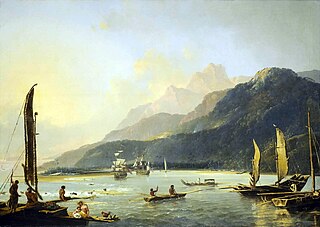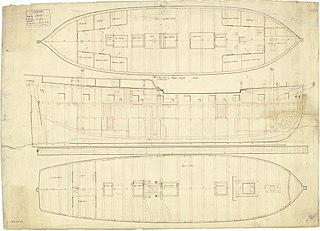Nine ships of the Royal Navy have borne the name HMS Albion after Albion, an archaic name for Great Britain:
Nine ships of the Royal Navy have been named HMS Meteor after the meteor, a space object.

HMS Adventure was a barque that the Royal Navy purchased in 1771. She had been the merchant vessel Marquis of Rockingham, launched in 1770 at Whitby. In naval service she sailed with Resolution on James Cook's second expedition to the Pacific in 1772–1775. She was the first ship to circumnavigate the globe from west to east. After her return she served as a store ship until 1779. The navy sold her in 1783 and she resumed a civilian career, but retaining the name Adventure. She was lost in May 1811.
Eight ships of the Royal Navy have borne the name HMS Rattler:

Gracieuse was a 32-gun Charmante-class frigate of the French Navy. Renamed to Unité in 1793, she took part in the French Revolutionary Wars. The Royal Navy captured her in 1796 off Île d'Yeu and brought her into British service as HMS Unite. She was sold in 1802

HMS Rattler was a 16-gun sloop of the Royal Navy. Launched in March 1783, she saw service in the Leeward Islands and Nova Scotia before being paid off in 1792 and sold to whaling company Samuel Enderby & Sons. She made two voyages as a whaler and two as a slave ship before she was condemned in the Americas as unseaworthy in 1802. She returned to service though, sailing as a whaler in the northern whale fishery, sailing out of Leith. She continued whaling until ice crushed her in June 1830.

The French corvette Naïade was launched at Brest in 1793 as a brig-corvette for the French Navy. The Royal Navy captured her in 1805 and took her into service as HMS Melville. She was sold for breaking up in 1808.
HMS Sparkler was an Acute-class gunvessel launched in 1797 as GB No.7 and renamed HMS Sparkler in August 1797. She served the Royal Navy during the French Revolutionary Wars. The Navy sold her in 1802. She became a merchantman. In 1813 a French privateer captured her but the Royal Navy recaptured her shortly thereafter. She was wrecked in February 1814.
HMS Manly, was originally the merchant ship Experiment, launched in 1792 at Leith. The British Royal Navy purchased her in 1797, used her as a gun-brig escorting convoys, and then sold her in 1802. New owners sailed her between London and Monserrat; she was last listed in 1816.
HMS Meteor was originally the merchant ship Lady Cathcart launched at Leith in 1794. The Royal Navy purchased her in 1797, used her as a gun-brig escorting convoys in the North Sea, and sold her in 1802. She then returned to mercantile service under her original name and continued to trade along the British coast. She was last listed in 1822.
HMS Mastiff was launched at Hull in 1790, as Herald. From there she traded with the Baltic. The British Royal Navy purchased her in 1797, had her fitted at Leith, and named her GB №35, and then Mastiff. She served as a convoy escort in the North Sea until she wrecked in 1800.
HMS Princess was the Dutch East Indiaman Williamstadt en Boetzlaar that the British Royal Navy captured on 18 August 1795 at the Capitulation of Saldanha Bay. The Royal Navy initially rated her a 28-gun sixth rate. She quickly became a receiving ship, a guard ship, and a floating battery. The Navy sold her in 1816.
HMS Vulture was launched in 1801 at South Shields as Warrior. The Royal Navy purchased her in 1803 as a sloop and renamed her. From 1808 through 1813 she was a floating battery at Jersey,. The Navy sold her in 1814 and she returned to mercantile service as Warrior. She was last listed in 1820, but does not seem to have sailed again after returning from east of the Cape in 1817.
There have been several ships named Hope:
HMS Hermes was the mercantile Hermes launched at Shields in 1797. The British Royal Navy purchased her in 1798 and sold her in 1802 after the Treaty of Amiens. She then returned to mercantile service as a West Indiaman. The French captured her in 1805.
HMS Dart was an 8-gun lugger, reportedly previously the British privateer Dart, built in 1796, captured by the French in 1798, recaptured from the French in 1803, and sold in 1808.
The Dutch corvette Waakzaamheid was launched at Enkhuizen in 1786. The French Navy captured her in 1794 and renamed her Vigilance. She was part of a squadron that in 1794 captured or destroyed a large number of British merchant vessels on the Guinea coast. The French returned her to the Dutch, in 1795. The Dutch Navy returned her name to Waakzaamheid. The British Royal Navy captured her without a fight in 1798. She then served as HMS Waaksaamheid until she was sold in September 1802.
HMS Albion was the mercantile Albion launched at Sunderland in 1797 that the Royal Navy purchased in 1798. The Navy sold her at Sheerness in 1803. She became a transport. It is possible that she foundered in August 1808.
HMS Alecto was an Alecto-class sloop designed by Sir William Symonds, Surveyor of the Navy. Originally classed as a steam vessel (SV3), her classification would be changed to a Third Class Sloop. She initially served in the Mediterranean, prior to her tug of war with the Rattler. She spent her time in the Americas and mainly on the anti-slavery patrol off the west coast of Africa. She was broken in November 1865
HMS Pouncer was the mercantile David, launched in 1785 at Leith, that the Admiralty purchased and armed in 1797 as GB No.38. David originally sailed to the Baltic and then to the Mediterranean. From 1793 or so till her sale to the Admiralty she sailed as a transport under contract to the Transport Board. The Navy renamed GB No.38 HMS Pouncer, and she was the only naval vessel ever to bear that name. The Navy sold Pouncer in 1802 following the Peace of Amiens. She then returned to mercantile service as the West Indiaman David. Under several masters and owners she traded more widely. In 1816 she sank, but was recovered.



